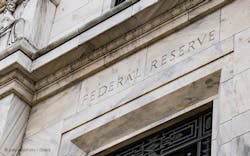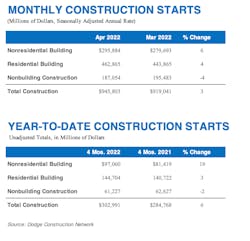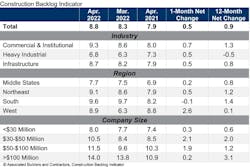When the Federal Reserve raised its benchmark interest rate by half a point at its May 4 meeting, that marked the Fed's largest increase in 22 years, aimed now at taming 2022's historic inflation.
For perspective, though, note that May 2000's hike of 50 basis points at the time pushed that target rate up to 6.5%. In contrast, this month's bump nudged the still-pancaked pandemic rate up to just 0.75-1.0%. So, the Fed still believes it has more room with which to play without triggering recession. Indeed, some even expect additional 50-basis point hikes, if necessary, this summer.
“Inflation is much too high and we understand the hardship it is causing," said Fed Chair Jerome Powell on May 4. "We’re moving expeditiously to bring it back down (and) we’re strongly committed to restoring price stability.”
So far, the AEC industry appears undeterred.
“The construction sector is seemingly shrugging off the fear of higher interest rates and a potential recession,” said Richard Branch, chief economist for Dodge Construction Network, speaking May 18. “Many building sectors have made the turn from weakness to recovery as underlying economic growth and hiring are solid. With the pipeline of projects in planning continuing to expand, this trend should continue in the months to come. However, the concern that the Federal Reserve will force the U.S. into recession later this year may thwart the momentum in construction starts. While recession is not our baseline forecast, it can not be fully discounted.”
According to Dodge, total U.S. construction starts rose 3% in April to a seasonally adjusted annual rate of $945.8 billion. Nonresidential building starts rose 6% and residential starts increased by 4%, while nonbuilding starts fell 4%.
Year-to-date, total construction was 6% higher in the first four months of 2022 compared to the same period of 2021. Nonresidential building starts rose 19%, residential starts gained 3%, while nonbuilding starts were 2% lower. For the 12 months ending April 2022, total construction starts were 12% above the 12 months ending April 2021. Nonresidential starts were 24% higher.
For the 15th consecutive month, architecture firms reported increasing demand for design services in April, according to the latest American Institute of Architects' Architecture Billings Index (ABI) score, released May 18. April's measure was 56.5 compared to 58.0 in March. (Any score above 50 indicates an increase in billings.) During April, scores for both new project inquiries and design contracts moderated slightly, but remained strong, posting scores of 62.3 and 55.4, respectively.
“While business conditions at architecture firms have been very encouraging over the past year, project activity has been steadily shifting toward work on existing buildings,” noted AIA Chief Economist, Kermit Baker, Hon. AIA, PhD. “Billings for reconstruction projects exceeded those for new construction for the first time in the last two decades. While the reconstruction share of building activity will continue to ebb and flow, in general, we’ll continue to move toward an increased share of building activity for reconstruction and a decreased share for new construction.”
Be it reconstruction or new construction, the amount of work is such that hiring is truly at a premium now.
"We continue to have a really strong economy, with unemployment rates at near-record lows," noted Erin McLaughlin, VP of Private Markets Resources at the American Council of Engineering Companies (ACEC). Speaking online May 12 in her monthly economic brief, she added, "The overall unemployment rate held at 3.6% in April, which begs the question: Are we at full employment? Well, our industry is even lower, because engineering and architecture is measured under the professional services sector, and that rate is at 1.6%."
Factor in hiring at contractors and subcontractors and overall construction employment edged up by 2,000 jobs between March and April, according to national monthly data compiled by the Bureau of Labor Statistics (BLS). Of note, 19,000 jobs were added between February and March, so the pace of hiring did slow considerably. Not surprisingly, a number of factors were in play.
“The pause in employment gains last month most likely signifies a shortage of qualified workers, rather than any slowdown in demand for projects,” said Ken Simonson, chief economist for the Associated General Contractors of America (AGC). “In fact, job openings in construction hit an all-time high at the end of March, while the industry’s unemployment rate was the lowest ever recorded for April.”
According to BLS, the unemployment rate among jobseekers with construction experience tumbled from 7.7% in April 2021 to 4.6% a year later, the lowest April rate recorded since the series began in 2000. Overall, there were 415,000 construction-industry job openings in the U.S. at the end of March, a jump of 69,000 or 20% from March 2021. That was the largest total for any month since that series began in 2000, Simonson noted.
Indeed, the supply of labor and materials seems to be the only things holding the industry back this spring and summer, as project backlogs continue to grow. On May 10, Associated Builders and Contractors (ABC) reported that its Construction Backlog Indicator had increased to 8.8 months in April, according to an ABC member survey conducted from April 20 to May 4. That reading was up 0.9 months from a year ago.
Still, ABC’s Construction Confidence Index readings for sales and staffing levels declined in April, while the reading for profit margins moved higher. All three indices remain above the threshold of 50, however, indicating expectations of growth over the next six months.
“Nonresidential construction is generally a sector that lags behind the broader economy, meaning emerging economic weakness will not show up in (that) data for months to come,” explained Basu. “It is conceivable that the risk of recession is overstated, and that contractors will thrive during the years ahead because of significant infrastructure spending. Conversely, it is also possible that the combination of higher interest rates, stubborn inflation, depressed confidence, geopolitical conflict and an economy-wide downturn will have fundamentally altered the industry’s outlook a year from now. Only time will tell."
In the meantime, inflation remains the biggest near-term hurdle, as reflected in the Fed's latest, more aggressive actions.
Prices of materials and services used in new nonresidential construction leaped nearly 21% in April from year-ago levels, according to an AGC analysis of new government data. AGC urged the Biden Administration to provide relief to hard-hit employers by ending tariffs on key construction materials and by reconsidering its recently proposed "Buy America" regulations that will make it harder for firms to find and pay for key construction materials, the association claimed.
“Nonresidential contractors have endured 12 months of 20% increases in the cost of items they need to build projects,” said Simonson. “While they have been able to pass some of those increased costs on to clients, most of those increases have come out of their own bottom line.”
The producer price index for inputs to new nonresidential construction—the prices charged by goods producers and service providers such as distributors and transportation firms—rose 0.8% from March to April and 20.9% over the past 12 months. An index for new nonresidential building construction—a measure of what contractors say they would charge to erect five types of nonresidential buildings—rose 4.1% for the month and 19.9% from a year earlier. April 2022 marked the 19th consecutive month in which the cost index rose more than the bid-price index on a year-over-year basis, Simonson added.
A wide variety of inputs accounted for the increase in the cost index. The price index for diesel fuel jumped 86.5% over 12 months. The index for aluminum mill shapes climbed 44.8%. The index for architectural coatings such as paint soared 32.1%. There were increases of more than 20% in the indexes for plastic construction products, which rose 29.9%; truck transportation of freight, 27.4%; steel mill products, 25.1%; and roofing asphalt and tar products, 20.8%.
In addition, there were double-digit increases in several other price indexes that affect construction costs, Simonson noted. He cited as examples the index for insulation products, which rose 19.6% over 12 months; gypsum products, 17.8%; copper and brass mill shapes, 16.8%; paving mixtures and blocks, 14.4%; and concrete products, 10.9%.
And yet, despite it all, the industry's momentum bulls ahead. The next few months may hold the key to whether economic stability can be regained without triggering an actual recession.
##########
.
About the Author
Rob McManamy
Editor in Chief
An industry reporter and editor since 1987, McManamy joined HPAC Engineering in September 2017, after three years with BuiltWorlds.com, a Chicago-based media startup focused on tech innovation in the built environment. He has been covering design and construction issues for more than 30 years, having started at Engineering News-Record (ENR) in New York, before becoming its Midwest Bureau Chief in 1990. In 1998, McManamy was named Editor-in-Chief of Design-Build magazine, where he served for four years. He subsequently worked as an editor and freelance writer for Building Design + Construction and Public Works magazines.
A native of Bronx, NY, he is a graduate of both the University of Virginia, and The John Marshall Law School in Chicago.
Contact him at [email protected].


